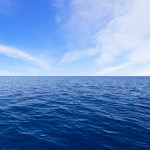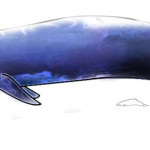
We’ll start with Timmy in the equatorial Atlantic. Here, Timmy is warm and salty, like a pirate. The Gulf Stream is a big bully and forces Timmy away from his pleasant tropical vacation towards the Arctic. Here, Timmy obviously becomes colder which also makes him dense and not just in the head. Timmy’s new found weight issues cause him to sink to the dark, deep seafloor. Just as Timmy gets comfortable the next water mass behind Timmy, Bobby, pushes Timmy out of the way.
So Timmy heads back toward the Equator along the seafloor, longing for his days in the tropics with supple views. However, Timmy overshoots and heads to the Antarctic Circumpolar, and begins a world tour with shows in Africa and Australia, until he heads North again in the bottom of the Pacific. Watch out Timmy the Pacific is tough place for a water mass. Despite being miles from his starting point, Timmy does not fret because he is warming, loosing some weight, and rising to the sunshine of the surface. Timmy continues his journey on the surface back toward the Indian Ocean, around the tip of Africa, and into the Atlantic. Oh No! Here Timmy goes again.
It should already be apparent, without getting into specifics, that the global movement of water masses would be interrelated with the weather patterns that affect continents. Thus any disruption of the MOC is likely to have profound consequences on global climate patterns, and vice versa. Previously, scientists have reported that the MOC is slowing potentially from surface warming and/or decreased salinity caused by freshwater runoff from rain and meltwater from glaciers and the Greenland Ice Sheet. A study in 2004 found that subpolar circulation may have been weaker in the late 1990s than in the late 1970s and 1980s. Another study in 2005 suggested that the Atlantic MOC had slowed by about 30% between 1957 and 2004. This perceived slowdown is considered support for predictions that global warming would disrupt the planet’s heat regulation.
But, a new set of studies in Science, suggests that normal variation in the MOC may account for previous declines. “We can’t strictly say they are wrong, but we can have an alternative explanation,” said coauthor Torsten O. Kanzow. Why the difference in findings? Previous studies were based on data points taken at discrete moment in time that masked short-term temporal variations. The new study focuses on several mooring over a span of 12 months starting in March 2004, the researchers found that the flow of water varied from 4.4 to 35.3 megatons per second, the range of values previously used to identify a downward trend.
Of course, now enter all the global warming denialists, who are rounding up the troops and spewing more of their idiocy even as I type this post. Of course, let’s keep in mind a very important concept. The new study simply shows that inter-annual variation is as large as the previously reported decline. However, the subtle point is that the two really address separate although related concepts, the annual mean and variance within a given year. The question is whether the downtrend in previous years is simply normal variation. For example, gas at my local station varied approximate from $2.50 to $3.50 per gallon within the last year. Over the last 3 years, the mean price per year has also increased from $2.50 to $3.50. So in light of the variance of single year, do we say that there has been no increase in price of gas over time? Obviously, my bank account knows the difference.
The important part of this study and the one the media and skeptics have overlooked is that this study lays the groundwork and oceanographic infrastructure by which the MOC can be monitored more precisely. The question in mind, whether the MOC is deteriorating is still open ended.
*Before you comment with the nauseating denialist wackjobbery, although I have doubt you have read this far, let me save you the trouble “THIS STUDY CLEARLY SHOWS AL GORE IS WRONG AND GLOBAL WARMING IS A MYTH”






Just out of curiosity: how long does it take for Timmy the Water Mass to actually circulate around like that?
The acronym MOC is indeed unfortunate. The denialists will be unmerciful in their MOCking.
You are right about the infrastructure needed to get usable data. Unfortunately it means that we know very little about the past flux, so establishment of long term changes to the total flow will take a very long time. I think the time span to prove anything about MOC, is longer than the timespan we need to react to GW. This is NOT an argument against gathering the data, if the circulation is indeed significantly changing due to climate change, the improved knowledge will be indispensible in the future. But I do believe we can’t expect “proof” of ocean circulation changes to drive policy.
Timmy’s full loop is estimated to be between 500-1000 years.
As predicted, the bandwagon is rolling. Steven Maloy, of the ironically titled junkscience.com, writes in the Canada Free Press about us “alarmists”. Why is it when someone highlights a real problem they are labeled an alarmist? …Mr. Smith I don’t mean to cause you grief but the the cancer has spread…Well Doctor I believe your an alarmist so am ignoring you. Steven ends his article with “Does it really make sense to regulate first and ask questions later?” as a direct rebuke of the Precautionary Principle. The answer is yes we should.
I think you mean Steven Milloy.
As for the precautionary principle, please distinguish it from “regulate first and ask questions later.” If that’s how one understands the PP, then it’s worse than worthless as an underpinning for sound policy.
Bob,
Great point about PP. But it struck me in Milloy’s original post this is what he was targeting. Obviously, PP is not the cowboy approach that is often proposed to be. Rather, the PP has a strong component of gathering more information to better inform future decisions.
Did you mean to write “50-100” or “100-500” years?
500-1000
I didn’t hear much about the MOC in my marine ecology class, except that it’s a load of crap (paraphrasing my professor). :)